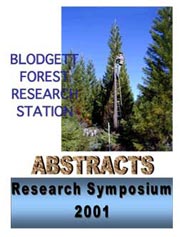ABSTRACT 9
Observational Constraints on the Contribution of Isoprene Oxidation to Ozone Production
Gabrielle B. Dreyfus, Gunnar W. Schade, and Allen H. Goldstein
|
|
|
Measurements of isoprene, its oxidation products methacrolein (MACR) and methyl vinyl ketone (MVK), and ozone were used to calculate the contribution of isoprene oxidation to ozone production downwind of Sacramento, CA. Oxidation of isoprene by OH in the atmosphere leads to the production of both MVK and ozone in distinct quantities. During the early afternoon, mixing ratios of MVK and ozone were highly correlated at our measurement site on the western slope of the Sierra Nevada mountains. We analyzed the slope of this correlation for individual days from July 12 through October 31, 1998, and compared it to the theoretical value of ozone per MVK produced in the oxidation of isoprene. The ratio of calculated to measured slope indicates the contribution of isoprene oxidation to the region's ozone production. Isoprene's contribution was found to increase exponentially with temperature, which is consistent with its temperature dependent emission from plants. Ozone production was dominated by isoprene oxidation on over 40% of the observed days and 66% of hot days (Tmax > 26C). This suggests that reducing anthropogenic hydrocarbon emissions in the Sacramento valley would not be a good strategy for reducing ozone levels in the Sierra Nevada mountains.
|
Contact Author: Gabrielle B. Dreyfus, 151 Hilgard Hall, ESPM, University of California, Berkeley, CA 94720-3110
|
|
|

